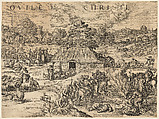The Parable of the Good Shepherd
Anonymous, Netherlandish, late 16th century Netherlandish
Attributed to Joris Hoefnagel Netherlandish
Not on view
This large political broadsheet is just a fragment of the original. The figures and animals cut off on either side indicate that the original would have extended further on either side. The only other known impression from this plate is an even smaller fragment in the Kunstsammlungen der Veste Coburg which only consists of the scene in the bottom right where they are burning sheep on a bonfire.
The image is an anti-Catholic and anti-Spanish Reformation period broadsheet that relates to the bibilcal passages from Ezekiel 34 and John 10. In the bottom right sheep are thrown on a bonfire to cook while a bishop, a pope a monk look on. Among the group on the right is a cardinal wearing the brimmed hat associated with his position, who resembles Cardinal Granvelle, the Spanish appointed chief councilor to the Regent, Margaret of Parma, and behind him on horseback, a man in armor who resembles the Duke of Alva, Governor of the Netherlands from 1567. The scene relates to the passage from Ezekiel 34 : "Shepherds ought to feed their flock, yet you have fed on milk, you have dressed yourselves in wool, you have sacrificed the fattest sheep but failed to feed the flock...On the contrary, you have ruled them cruelly and violently"
The scene in the center is focused on a cottage where a pope is trying to enter through the roof while Christ, dressed as a shepherd, leads a flock of sheep out the front door. It relates to the passage from John 10: "I tell you solemnly anyone who does not enter the sheepfold through the gate but gets in some other way is a thief and a brigand"
This image cannot be enlarged, viewed at full screen, or downloaded.


